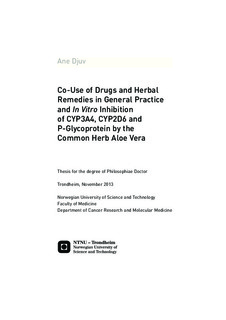| dc.contributor.author | Djuv, Ane | nb_NO |
| dc.date.accessioned | 2014-12-19T14:18:58Z | |
| dc.date.available | 2014-12-19T14:18:58Z | |
| dc.date.created | 2013-11-28 | nb_NO |
| dc.date.issued | 2013 | nb_NO |
| dc.identifier | 680305 | nb_NO |
| dc.identifier.isbn | 978-82-471-4806-8 (printed ver.) | nb_NO |
| dc.identifier.isbn | 978-82-471-4807-5 (electronic ver.) | nb_NO |
| dc.identifier.uri | http://hdl.handle.net/11250/263663 | |
| dc.description.abstract | There is a widespread use of complementary and alternative medicine (CAM) and herbal remedies in particular in different patients groups, but very few are published about co-use among patients in general practice (GP) and herb-drug combinations at risk. Co-use of herbal remedies and drugs can result in none or server adverse effects. Of this reason, knowledge about the GP patients co-use and research on mechanisms of such interactions is needed.
The aims of this thesis were divided; 1) To register the co-use of drugs and herbs among GP patients in Norway and the patients communication of such use with health care professionals; 2) To evaluate the interaction potential of one of the commonly used herbs in GPs office, Aloe vera (Aloe barbadensis), on the P-glycoprotein (P-gp) and the cytochrome P-450 (CYP) enzymes, CYP3A4 and CYP2D6.
Among the 381 patients answering the questionnaire in the GP office, 44% used herbs. The most common herbs were bilberry (41%), green tea (31%), garlic (27%), Aloe vera (26%) and purple coneflower (18%). Almost every third (29%) patient co-used drugs and herbs. They combined 255 different drug-groups and herbs whereas 18 of these were considered to have a clinically relevant interaction potential. Close to 40% of patients on anticoagulants co-used herbs, reporting garlic and bilberry most frequently. Co-users had significantly (p<0.05) increased odds to be female, elderly, use herbs to treat an illness, use two or more herbs and experienced adverse effects of herbal use compared to other GP patients. Co-use was also associated with use of analgesics or dermatological drugs. Only 23% of the GP patients discussed their herb use with a health care professional.
Even though Aloe vera is a well-known, old medicine plant used both in cosmetics and as therapeutics, few or no earlier systematic research on its interaction potential has been investigated when co-used with drugs in vitro. Overall three enzymes accounts for the majority of the pharmacokinetics on the drugs in the market: the efflux-protein P-gp transporting the medicinal drug out of the cell and CYP3A4 and CYP2D6, metabolizing the medicinal drugs to less active components. These enzymes can be influenced by other substances (inhibited or induced) and is therefore important regarding herb-drug interactions.
Aloe vera juice (AVJ) did not inhibit P-gp mediated digoxin efflux for the investigated AVJ concentrations in vitro. However, it was shown that both AVJ (10.0 mg/ml) and digoxin (≥3µM) was cytotoxic in large concentrations. Two different AVJs were used in the CYP3A4 and CYP2D6 assays. Both juices inhibited CYP3A4 and CYP2D6 irreversible in vitro, having significant different IC50 values. This can come from different concentrations of active components in the juices. Both IC50 values seems, however, to be too high to be clinical relevant alone. Precautions should although, be made with excessive consumption of AVJ, with poor CYP2D6 activity ("poor metabolisers") or with use of drugs having a narrow therapeutic window.
It can be concluded that GP patients co-using drugs and herbs and that this use can give clinical relevant interactions (e.g. excessive haemorrhage when co-using garlic and warfarin). Elderly patients are most vulnerable for co-use. One of the common used herbs among GP patients, Aloe vera, was investigated for in vitro pharmacokinetic interactions on the enzymes P-gp, CYP3A4, CYP2D6. Although it was concluded with low possibility of clinical relevant pharmacokinetic interactions co-using Aloe vera and drugs, patients with poor CYP2D6 activity might risk interactions when co-using large quantities of Aloe vera with conventional drugs which is metabolized of CYP2D6 (e.g. codeine). Clinical in vivo studies are needed to reveal any interactions in humans for Aloe vera and other herbs at risk of herb-drug interactions. Until then, the GPs and other health care professionals are advised to ask all patients about herbal use. | nb_NO |
| dc.language | eng | nb_NO |
| dc.publisher | Norges teknisk-naturvitenskapelige universitet, Det medisinske fakultet, Institutt for kreftforskning og molekylær medisin | nb_NO |
| dc.relation.ispartofseries | Doktoravhandlinger ved NTNU, 1503-8181; 2013:333 | nb_NO |
| dc.relation.haspart | Djuv, Ane; Nilsen, Odd Georg; Steinsbekk, Aslak. The co-use of conventional drugs and herbs among patients in Norwegian general practice. BMC complementary and alternative medicine. (ISSN 1472-6882). 13(1): 295, 2013. <a href='http://dx.doi.org/10.1186/1472-6882-13-295'>10.1186/1472-6882-13-295</a>. <a href='http://www.ncbi.nlm.nih.gov/pubmed/24171723'>24171723</a>. | nb_NO |
| dc.relation.haspart | Djuv, Ane; Nilsen, Odd Georg. Aloe vera juice. Phytotherapy Research. (ISSN 0951-418X). 26(3): 445-51, 2012. <a href='http://dx.doi.org/10.1002/ptr.3564'>10.1002/ptr.3564</a>. <a href='http://www.ncbi.nlm.nih.gov/pubmed/21842479'>21842479</a>. | nb_NO |
| dc.relation.haspart | Djuv, Ane; Nilsen, Odd Georg. Caco-2 cell methodology and inhibition of the P-glycoprotein transport of digoxin by Aloe vera juice.. Phytotherapy Research. (ISSN 0951-418X). 22(12): 1623-8, 2008. <a href='http://dx.doi.org/10.1002/ptr.2536'>10.1002/ptr.2536</a>. <a href='http://www.ncbi.nlm.nih.gov/pubmed/19003953'>19003953</a>. | nb_NO |
| dc.title | Co-Use of Drugs and Herbal Remedies in General Practice and In Vitro Inhibition of CYP3A4, CYP2D6 and P-Glycoprotein by the Common Herb Aloe Vera. | nb_NO |
| dc.type | Doctoral thesis | nb_NO |
| dc.contributor.department | Norges teknisk-naturvitenskapelige universitet, Det medisinske fakultet, Institutt for kreftforskning og molekylær medisin | nb_NO |
| dc.description.degree | PhD i molekylærmedisin | nb_NO |
| dc.description.degree | PhD in Molecular Medicine | en_GB |
